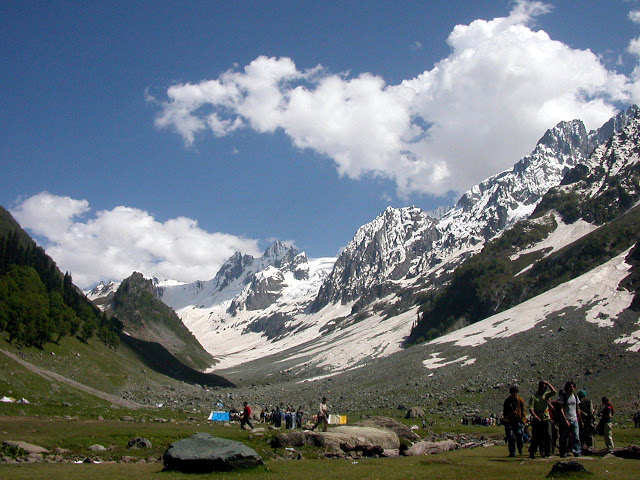
Pahalgam and Sonamarg areas of the Kashmir valley have been declared out of bounds for school excursions “in view of the ensuing Amarnath Yatra”. The timing of the ban, imposed by the School Education Department of Kashmir on school picnics to Pahalgam and Sonamarg, is quite interesting. The ban comes in the backdrop of the warning of the Indian army about a possible militant attack on the yatra. While the warning runs contrary to the tall claims of the security establishment in Kashmir, that militancy has been, more or less, eliminated, it does serve the purpose of the state to manufacture fear and impose a sense of uncertainty among the people.
One of the important visible aims is to create fear psychosis among the natives as well as the yatris. This manufactured fear is aimed to give legitimacy to the presence of the security forces across the length and breadth of Kashmir. And as a result, all the debates regarding the repeal or partial withdrawal of draconian laws like AFSPA, Disturbed Area Act and Public Safety Act are stealthily laid to rest without much opposition. And the laws continue to be there. The yatra also means that Kashmiri policemen are coerced to be at the disposal of the pilgrims for two months. That their posting is coercive was evident from the recent hunger strike and protests by the new recruits of the JKP, undergoing training at the Ganderbal Police Training Centre.
The manufacture of threat is not a new thing in Kashmir. Back in 2012, a cooking gas cylinder blast, in a vehicle carrying some tourists in Islamabad, was initially reported as a grenade attack on yatris in the Indian national media. Similarly, when militants attacked a CRPF camp early this year in Bemina, one of the Indian TV channels went to the extent of falsely reporting it as an attack on a school run by the J&K Police, and further declared that 5 students died in the attack, while in reality the school was closed on that day and there were no civilian casualties.
One more aspect of this perceived threat is that it reaffirms the Islamic Extremism rhetoric, which is often used to downplay the struggle of the Kashmiris. It has been a convenient way all along to malign the Kashmiri struggle as being communal, and this particular Hindu pilgrimage provides an opportunity for the state to turn the tide in favour of its own narrative. As we know, branding it as Islamic Extremism is the easiest way to turn any struggle of Muslims in any part of the world illegitimate. Islamic Extremism, with its different shades and different definitions in different parts of the world, when linked with Kashmir, makes it easy for the world to forget the various human rights violations being meted out to the Kashmiris on one pretext or the other.
Keeping in view the fact that this threat perception was well received by the central government, notwithstanding the clear rejection at the state government level, a political angle cannot be avoided with the general elections due next year. The Congress may want to turn the tide completely in its favour, eyeing the religious Hindu vote base, pretending to be acting as the saviour of the beliefs of the majority Hindu community, given that the Army has already invoked ‘Operation Shiva’ to ‘sanitize the hills around the route’! Furthermore, this decision points to the incompetence and irrelevance of the state government, as well as the fact that it is just an extension of the central government of India. It is just an instrument or interface between the decision maker (the central government) and the executing body, i.e., the army. The fact that there was no mention of any militant attack threat in the recent meeting of the Unified Headquarters, headed by J&K Chief Minister, makes it amply clear that this threat perception has been conceived at the centre only.
It is interesting to note here that even during the peak of the 2008 popular uprising, which was sparked off by an issue related to the same Amarnath yatra, the yatra went off peacefully without any harm done to a single pilgrim. This leads to the conclusion that the only visible threat to peace is the State itself.








